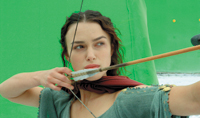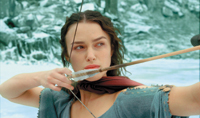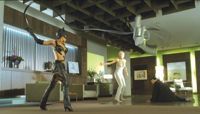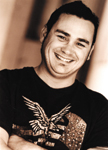The half-dozen visual effects professionals interviewed for this article see several trends, one being an increased reliance on them to do more with less preproduction. As characters such as Golum from The Lord of the Rings break new ground, these creators are challenged to raise their own bars. Their concerns are many, including imaginary cutoff dates and new tool versions that are more general than specific.
Their solutions? A heavier emphasis on their own shops' R&D for streamlining their own pipelines, getting software makers to write custom versions for them (it helps if you have the clout of Digital Domain) or aggressively making design decisions and, then, selling clients on those ideas.

Digital Domain worked on 530 visual effects shots for I, Robot, including giving lead robot Sonny a personality.
|
SNOW AND ICE FOR KING ARTHUR
One of the pivotal scenes in King Arthur is the ice battle. King Arthur and his men are leading a band of villagers to safety, away from the Saxon hordes, but when they come to a frozen river gorge, they stop and confront their enemy.
"We filmed this movie in August in Ireland and there aren't any frozen lakes. It was one of those little snags where everyone turns to look at the effects supervisor and says, 'That would be your department,'" laughs Matt Johnson, who performed that role for Cinesite UK (www.cinesite.co.uk/ ), which was the lead and only visual effects house, with 482 visual effects shots, on the summer 2004 film.
Then, "it became apparent at the time of shooting that the location wasn't really what [director] Antoine Fuqua had in mind for the movie. He wanted something far more rocky, dangerous and mountainous, and there aren't any mountains in Ireland. The movie's main challenge became how to turn what was there into something that Antoine and [producer] Jerry Bruckheimer wanted. For that particular sequence, we ended up replacing everything. The only real thing is the actors themselves, even the ground they're walking on - the gorge around them - has been, for the most part, digitally replaced or digitally enhanced," he adds.

|
At Cinesite UK with King Arthur, the R&D department, which Johnson calls "the brain trust," concentrated on speed by writing an artificial intelligence crowd simulation software that plugged into their Pixar RenderMan pipeline. It allowed him, in one day, to review a shot of thousands on the battlefield. In-house code also optimized the Cinesite system so when it rendered the army footage into 4K, it happened in hours instead of days.

Cinesite UK added ice covered mountains and snow to many shots for King Arthur, which was filmed in Ireland in the summertime.
|
The ice battle is 275 shots back to back, so in order to push through the volume and realistic detail required, Johnson mixed up approaches for the pipeline. He didn't want everything to go through the full 3D pipeline before it went into compositing. R&D developed a 3D space node as a plug-in to Apple Shake, the principal 2D compositing package used on the film. It was a 2 1/2-D solution that created the perception of parallax (where objects in the foreground move faster than those in the background) and perspective shifts that was used in the shots without wild moves.
Cinesite UK sent its senior matte painter Dave Early to the French Alps to shoot rock and mountain textures that were mapped onto 3D geometry. In most instances, Alias Maya 5 for both Windows 2000 and Linux 7.2 was the main software package. It ran on IBM Intellistation Z Pro with dual 3.0 GHz Xeon processors, Nvidia FX 1100 or 980GLX graphics.
TIGHT DEADLINES FOR THE TERMINAL
Ed Quirk also notes the heavier reliance on visual effects solutions. He's the Digital Filmworks (www.dfw-la.com/ ) senior 3D artist who handled visual effects for this summer's The Terminal. He says, "It's getting obvious that [directors] are just shooting free without any motion control rigs or without a lot of preproduction. They just decide on the set they're going to do a shot in CG and it's always left up to us to somehow make it work. Previously, they were very careful with motion control, but it does take a large chunk of time on the set. Now that they know they can get away without bothering, they don't bother.
"Another trend would be as far as the final cutoff," he continues. "Typically our deadline would be a month before release. Now it's getting shorter and shorter when they realize they can keep making changes right up 'til when they have to strike the prints," he adds, noting that the span is down to about two weeks. "For The Terminal, Spielberg reshot part of the ending. Memorial Day weekend they re-called Tom Hanks and they shot on the stage. It was due out about two weeks later and we had to do some treatment on those shots. It was pretty much down to the wire. I think in the future, when they go to digital and there won't be the need for striking all the prints, they'll go down to the last minute. They'll be making changes right before it screens." The Terminal takes place inside, with windows that open to paintings by Robert Stromberg. Quirk had to add vehicles, planes and people to give those paintings life, doing a lot of match motion even though there were no motion control rigs on the shoot. Fortunately, DreamWorks supplied the pre-production data used to design and build the set that - coupled with Quirk's own measurements and lens information for each shot - helped in motion tracking. He took reference footage at Los Angeles International Airport from which he built and textured baggage carts and vehicles. Digital Filmworks' half-dozen artists did all the effects work, about a dozen shots.
Some tracking was done by eye but 2D3's Boujou was also used. Most 3D work with done in Maya 5 on an SGI Octane, compositing with Shake and Illusion on the Octane, and Adobe Photoshop on a Mac G5. The painter Stromberg had done his backgrounds in Photoshop, so Quirk loaded those to start.
CREATING A STAR FOR I, ROBOT
Digital Domain (www.d2.com/ ) handles an enormous volume of visual effects - it did 530 shots of this summer's I, Robot, a number soon to be dwarfed by Stealth (2005) and its 800 shots. Andy Jones, DD's animation director and the animation supervisor on I, Robot, is also seeing the compressed timetable trend.

Frantic Films created a digital whip for Halle Berry to wield in Catwoman.They created a custom rig, based on an earlier rig by Escape, in 3DS Max.
|
"It was scary at times," he says." Every week we were falling short of what we needed to finish that week. Part of it is so many changes being made, part of it is we're pushing ourselves and the technology and pushing the quality and the amount of work so high that physically something has to break. In our contract we specifically stated that we needed delivery of these sequences before Christmas in order for us to finish on time, and we didn't get them until February. That's two months that we lost and yet they still require the same amount of work, same quality, same everything. Something's got to give."
Digital Domain's biggest task on the film was to create Sonny, the star robot. Jones' biggest concern was pulling off the performance that director Alex Perez wanted, by capturing the actor's performance and refining the facial animation tools. "That's what sold him on the project; we showed him how fast we could do the facial animation and make it look real. We knew we had to push it further," he says. Over 230 people worked on the film, including head technical director Eric Miller, who wrote a few plug-ins for more realistic facial animation through organic blend shaping and a more arc-based movement.

Asylum's Nathan McGinnis and crew supplied 150 VFX shots for Phantom of the Opera.
|
R&D also streamlines everything it can. It constantly writes translation tools for the new versions of its varied software lineup that ranges from Side Effects Houdini to NewTek LightWave to Alias Maya. And, in this case, Alias wrote a custom version of Maya to include name spacing and file referencing that allowed animators to save their animations to a file that could be referenced by lighters (who preferred their Maya to run on Linux boxes); that change was incorporated into Maya 6. Other tools included RenderMan with M2R, a RenderMan plug-in for Maya, on Linux boxes. LightWave running Windows 2000 was used for all set extensions, plus Houdini on Linux for particle effects and the Vicky character, who was made from surveillance footage composited together. In-house software Nuke, available for sale, was used for compositing.
WHIPPING UP VFX FOR CATWOMAN
Smaller shops like Frantic Films (www.franticfilms.com/ ), which did the whip sequences in this summer's Catwoman, also has its R&D department ease the pipeline. "Our goal is to stop relying on the off-the-shelf stuff so much," says visual effects supervisor Chris Bond. "That's our asset. That's one of the reasons people hire us because they know they're not going to get closed into a box two weeks before delivery when they want to change something and they can't."
Frantic Films is often awarded "the hardest things in the movie," he says, like the tar monster in Scooby Doo 2, the biggest bullet time shot in Swordfish or a room filled with millions of crystals in The Core. "Then we have to come up with ways to do them," he adds. "We keep increasing that R&D team [eight for 55 3D and visual effects artists], so I think for a smaller shop of our size we have a greater percentage of developers. We write a lot of software, we do a lot of custom stuff. We do a lot of previz as well so we come up with a lot of the ideas."

Digital Filmworks used Shake and Illusion for compositing work on The Terminal.
|
On Catwoman, Frantic did more than 30 shots. They created a custom rig in Discreet 3DS Max for the whip modified from an original Maya rig (from the lead visual effects house Escape) to better suit its pipeline. Renderers were Splutterfish's Brazil, Mental Images' Mental Ray or Chaos Group's Vray on AMD Athlon dual gig machines running Windows 2000. Compositing was done on Eyeon Digital Fusion.
Bond is concerned that 3D software makers are becoming generalists rather than remaining the specialists they started as.
"Now people are relying on off-the-shelf programs to do things like cloth and liquid and fur, and it's becoming harder and harder, from my perspective, to see the company that creates those tools increase the feature set of all these different aspects every time. Instead of becoming the 'fastest modeling program' or 'fastest animation program' it's 'we've got animation/modeling/fur/cloth/dynamics' and the list goes on," he says. "Every time there's a new generation of software it seems like the leap in the technology is slower because they're trying to do 1,000 features instead of 10. There are things that we want out of software from three or four generations ago - like scalability - we get projects and files that are huge and the 3D programs can pretty much handle the same size files they could three to four years ago and the projects are now 15 times larger. Expectation in film and games, everybody wants more geometry, more objects, more characters, bigger scenes and they want to see a giant city, and it becomes harder to manage that."

Pixel Magic worked on 35 shots for Exorcist: The Beginning, including this one that incorporates a matte painting.
|
PHANTOM EFFECTS
In Santa Monica, Asylum (www.asylumfx.com/ ) owner Nathan McGinnis bucks the trends. His company's R&D department spends more time creating unique looks for films rather than easing the pipeline, which, he says, isn't really an issue. And those schedule time crunches? Not affected by those either, he says.
"If you've done a really good job there shouldn't be any reason for them to come back at you. They'll keep milking you to the very end if they're not happy with it. The only time you know it's done is when they say it's done. If they keep coming at you it just means you haven't given them what they want and they're trying to find something," he says. "That's our job, to find what they're thinking and deliver it. The director sometimes doesn't know exactly what it is. It's our job as visionaries to deliver something which is interpolated from what they have said to us and they see it and go, 'Wow.'"
Asylum did the visual effects for 2001's Moulin Rouge and now is wrapping up all effects for Andrew Lloyd Weber's Phantom of the Opera (Christmas 2004), about 150 shots. A unique look is critical for each and every film Asylum helps create.
For Phantom, the visual effects house created the top third of the theater, the roof and dome hung with a giant chandelier; for which it used theater blueprints to model and texture. It also built a miniature of the theater, which is featured in the opening transformation sequence from its current decrepit state to one of grandeur in the late 1800s, a process that required many motion control passes. The most challenging part, says McGinnis, was marrying the miniature with the external plates.
All artists use Maya, Houdini and, for compositing, Discreet Flame and Inferno. "We're happy with the high-end tools because we feel they move faster, you have the ability to have the high-end artists and you get the work done 10 times as fast, generally, because of the artists and the machines. We have a 100-person staff, but we can work to the size of a 300-people house because I don't have a junior mentality. We're in LA and we're dealing with the number-one market, therefore it's very hard to use this marketplace as a training ground," he says. Asylum runs multiple platforms such as SGI and Linux.
"The concern is always to stay the leader in the market and to realize that there's always someone out there who could be coming up behind you. I try to look at the business as every day is the first day," he says.
CG DOUBLES FOR THE EXORCIST
At Pixel Magic (www.pixelmagicfx.com/ ), one of three houses that worked on this summer's Exorcist: The Beginning, CG supervisor Mike Hardison says, "The key to having a successful business is to always keep that edge and always strive for it to be cheaper, faster, better in order to stay competitive. I think that visual effects supervisors are beginning to realize that they can push their vision in the visual effects area more, so they are making more and more tweaks until the end. It's always been said that a shot is never completed... it's just abandoned. I think that the directors of visual effects supervisors are becoming aware of that. Is that bad? I don't think so. Our objective is to deliver what the client wants. It's not really an art, it's a business. That's what we're being paid to do."
Pixel Magic did worked on 35 shots, including an opening sequence that involved a lot of matte paintings as a priest crosses a battlefield and the camera reveals it strewn with dead soldiers, crosses, crows and sand. Another sequence enhanced gore during a suicide. The artists also did CG double work where a possessed character crabwalks on the wall.
"Generically there's more of a requirement for digital stunt doubles," says effects producer George Macri. "As technology gets better in terms of skin, cloth and hair simulators, digital doubles are coming closer to camera." For the crabwalk scene, artists used Syflex for cloth simulation because the main character wears a long flowing dress and she has long hair. In-house, R&D wrote additional scripts for hair and cloth simulation and, sometimes, artists just found it easier to hand keyframe some of the movements. Nearly a dozen CG artists and four compositors worked on the film.
The :30 opening battlefield sequence hooked up the CG environment with two live-action plates. The challenge was the number of elements: over 150 CG layers that required a tremendous amount of tracking and rotoscoping. For the opening, Maya 6 was used for dynamics and character animation while LightWave 7.6 was used for modeling and, after transporting to Maya and back, ultimately for rendering. Hardware was 2.4 dual GHz Pentium 4s running Windows and Linux (for After Effects, a little Shake and Maya render nodes). After Effects 6 on Macintosh G5s was the primary compositing tool because of the number of 2D generated elements and the toolset's flexibility of creating those elements independent of CG.